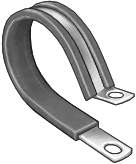 |
 |
 |
 |

|

|
|
|
|
|
|
Registered
Join Date: Mar 2005
Location: Tucson
Posts: 914
|
1974carrera
I installed the complete Rennaire kit last summer. I replaced all hoses with barrier type, switched to the Sanden 507 compressor, switched the evaporator & front condensor to new serpentine, added the procooler and changed to 134a. The system works great & Ron at Rennaire is very helpful. I was getting temps of about 38 degrees when it was in the upper 90's outside. The only thing that would improve the kit would be enough of those loop straps to replace the existing clamps since the barrier hoses are so much smaller in diameter. These:  Instead of these: 
__________________
1986 Carrera Coupe 1999 Chevy Tahoe 1987 Chevy Blazer 1955 Chevy Apache 3100 Pickup "A little knowledge is a dangerous thing" Last edited by Barrpete; 11-18-2006 at 10:04 AM.. |
||
|
|
|
|
Registered
Join Date: Oct 2004
Posts: 15,612
|
Barrpete,
That sounds like a nice project. I have the Pro Cooler, stock ND compressor, stock hoses and stock evaporator and condensers. I was thinking about installing new hoses and front condenser. Can you tell me why the new barrier hoses are so much smaller in diameter? It seems to me they would raise the operating temp by causing higher pressures to move the fluid around. On the other hand, it's not like the system has that much total refrigerant in it. |
||
|
|
|
|
Registered
Join Date: Mar 2005
Location: Tucson
Posts: 914
|
rusnak
I'm not1 sure exactly. Maybe Jim Sims or Kuehl could answer that one. I know that refrigerant (both R-12 & 134a I think) leak through the old style hose. I'm also not sure if the ID is any smaller, but the OD sure is. And you actually use a little less refrigerant with 134a vs. R-12. Somewhere around 80%-ish.
__________________
1986 Carrera Coupe 1999 Chevy Tahoe 1987 Chevy Blazer 1955 Chevy Apache 3100 Pickup "A little knowledge is a dangerous thing" |
||
|
|
|
|
Registered
Join Date: May 2000
Location: Los Alamos, NM, USA
Posts: 6,044
|
Standard refrigeration hose, barrier refrigeration hose and reduced barrier refrigeration hose all have the same ID for a given size (such as No. 6). I believe standard and barrier hose have about the same OD but reduced barrier hose has a significantly smaller OD. The "Adel type" rubber covered, loop clamps may be purchased from McMaster-Carr (bags of 25 or 50?) or you can use electrical conduit clamps (paint them black if you wish) of the correct size and use those to secure the reduced barrier hose.
|
||
|
|
|
|
Registered
Join Date: Oct 2004
Posts: 15,612
|
Soo.....the smaller looking hose has the same ID as my fat looking stock AC hose? I was thinking about taking all of the old hose ends down to my AC shop and have him make me some new hoses with brand new Goodyear barrier hose. The benefit is that it would look stock and use all of the stock clamps and stuff. Also, you know that the hoses have a tendency to rub against stuff like the engine lid struts, etc. I feel better about having all that extra thick hose material to keep the refrigerant under pressure where it's supposed to be.
|
||
|
|
|
|
Registered
Join Date: May 2000
Location: Los Alamos, NM, USA
Posts: 6,044
|
No, there are two types of barrier hose with different wall thicknesses and only the reduced barrier hose has the significantly smaller OD (and thinner wall). Existing fittings can be reused if the shop has ferrules for reduced barrier hose and the appropriate reduced barrier hose crimping dies for these ferrules. New flare type (as compared to o-ring) fittings to fit reduced barrier hose are not commonly found in many A/C shops. Therefore if your condenser/evaporator/compressor needs new flare type fittings with the reduced barrier hose it will be a bit more work: cutting off the ferrule from a new standard barrier hose flare fitting and then using a reduced barrier hose ferrule in it's place.
|
||
|
|
|

|